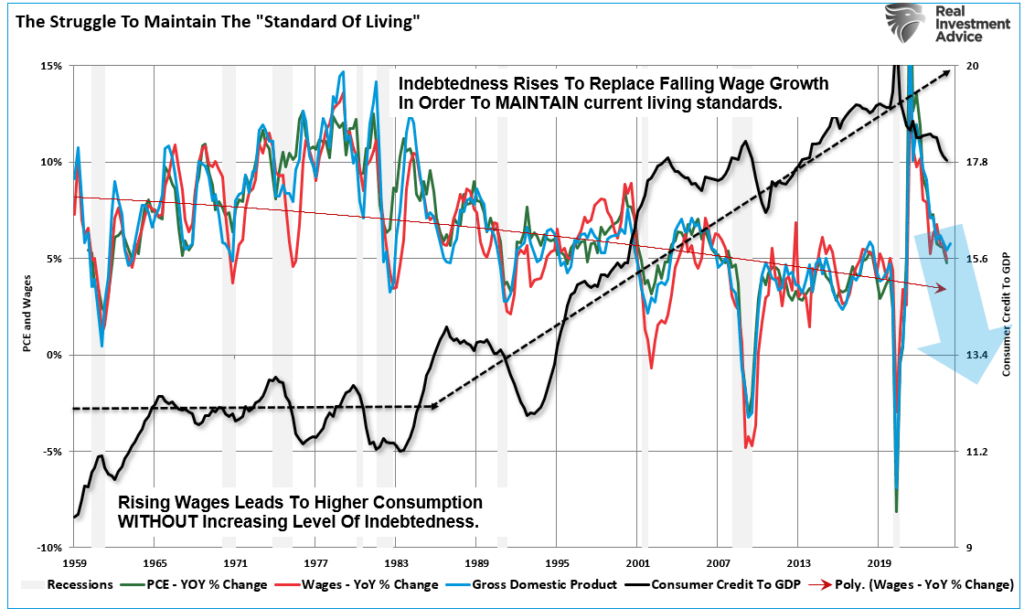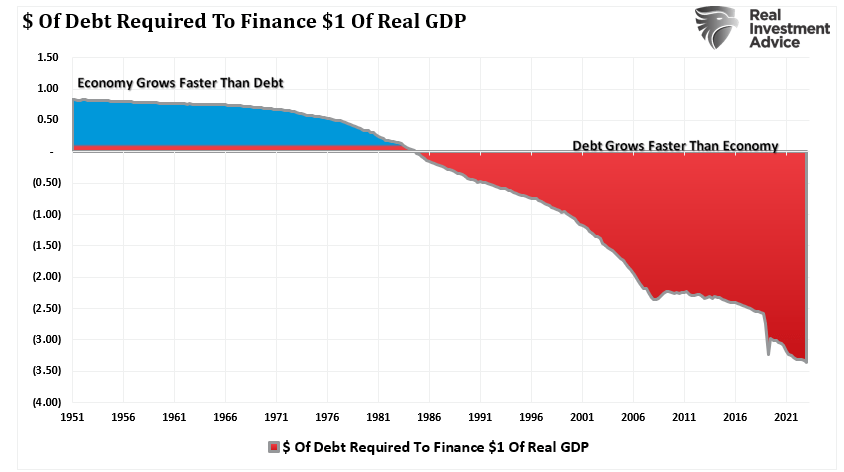I used to be not too long ago requested in regards to the seemingly robust “financial development” fee because the Federal Reserve prepares to begin chopping charges.
“If financial development is so robust, as famous by the current GDP report, then why would the Federal Reserve reduce charges?”
It’s a very good query that bought me serious about the pattern of financial development, the debt, and the place we’ll seemingly be.
For the reason that finish of the monetary disaster, economists, analysts, and the Federal Reserve have continued to foretell a return to increased ranges of financial development. The hope stays that the Trillions of {dollars} spent in the course of the pandemic-driven financial shutdown will flip into lasting natural financial development. Nevertheless, the issue is that whereas the unreal stimulus created a surge in inflationary pressures, it did little to spark natural financial exercise that may outlive the stimulus-related spending.
Pulling Ahead Development
Pulling ahead development during the last decade stays the Federal Reserve’s major device for stabilizing monetary markets whereas financial development charges and inflation stay weak. From repeated rounds of financial and financial interventions, asset markets surged, growing investor wealth and confidence, which, as Ben Bernanke said in 2010, would assist financial development. To wit:
“This method eased monetary circumstances prior to now and, thus far, appears to be efficient once more. Inventory costs rose and long-term rates of interest fell when traders started to anticipate the newest motion. Simpler monetary circumstances will promote financial development. For instance, decrease mortgage charges will make housing extra inexpensive and permit extra householders to refinance. Decrease company bond charges will encourage funding. And better inventory costs will increase client wealth and assist improve confidence, which may additionally spur spending.” – Ben Bernanke
That actually appeared to be the case as Federal Reserve interventions stored the monetary markets and economic system secure every time the economic system stumbled. Nevertheless, there may be ample proof that “financial coverage” results in different issues, most notably a surge in wealth inequality with out a corresponding improve in financial development.

The inherent drawback of pulling ahead consumption is that whereas it might resolve short-term financial considerations, it leaves an ever-larger “void” sooner or later that have to be crammed. The issue, unsurprisingly, is that “financial coverage” is just not expansionary. As proven, since 2008, the full cumulative development of the economic system has been simply $6.1 trillion. In different phrases, every greenback of financial development since 2008 required almost $6.7 of financial stimulus. Such sounds okay till you understand it got here solely from debt issuance.


In fact, the obvious drawback is that sustaining this quantity of debt-driven financial coverage is just not reasonable. However therein lies the problem of the “robust financial development” narrative.


The Lack Of Financial Development
Whereas economists, politicians, and analysts level to present knowledge factors and primarily coincident indicators to create a “bullish spin” for the investing public, the underlying deterioration in financial prosperity is a way more crucial long-term concern. The query that we needs to be asking is, “Why is that this taking place?”
From 1950-1980, nominal GDP grew at an annualized fee of seven.55%, completed with a complete credit score market debt to GDP ratio of lower than 150%. The CRITICAL issue is that financial development trended increased throughout this span, going from roughly 5% to a peak of almost 15%. There have been a few causes for this. First, decrease debt ranges allowed private financial savings to stay sturdy, which fueled productive funding within the economic system. Secondly, the economic system was targeted totally on manufacturing and manufacturing, which had a excessive multiplier impact on the economic system. This feat of development additionally occurred within the face of steadily rising rates of interest, which peaked with financial enlargement in 1980.


Nevertheless, starting in 1980, the shift of the financial make-up from a producing and production-based economic system to a service and finance economic system with a low financial multiplier is partially liable for this transformation. The decline in financial output was additional exacerbated by elevated productiveness via technological advances and manufacturing outsourcing, which plagued the economic system with steadily lowering wages. In contrast to the steadily rising financial setting earlier than 1980, the post-1980 economic system has skilled a gentle decline. Subsequently, a press release that the economic system has had a median development of X% since 1980 is grossly deceptive. The expansion pattern is way more vital and telling than the common development fee over time.
The Drag On Customers
This decline in financial development over the previous 40 years has stored the common American struggling to take care of their lifestyle. As their wages declined, they turned to credit score to fill the hole and preserve their present lifestyle. This demand for credit score grew to become the brand new breeding floor for the financed-based economic system. Extra accessible credit score phrases, decrease rates of interest, simpler lending requirements, and fewer regulation fueled the continued consumption growth. Whereas the economic system surged with the “free cash” despatched to households, reversing that profit will finally return the economic system, wage development, and consumption to the continuing long-term downtrend.


That’s the reason the financial prosperity of the final 40-years has been a fantasy. Whereas America, not less than on the floor, was the world’s envy for its obvious success and prosperity, the underlying most cancers of debt enlargement and declining wages was consuming away on the core. The one technique to preserve the “lifestyle” was to make the most of ever-increasing debt ranges. The now-deregulated monetary establishments had been solely too completely satisfied to offer that “credit score” because it was a monetary windfall of mass proportions.




Why “Socialism” Is Rising
The large indulgence in debt, what the Austrians name a “credit-induced growth,” has seemingly reached its inevitable conclusion. The unsustainable credit-sourced growth, which led to artificially stimulated borrowing, has continued in search of ever-diminishing funding alternatives. In the end, these diminished funding alternatives repeatedly result in widespread mal-investments. Not surprisingly, we noticed it play out “real-time” in all the pieces from subprime mortgages to by-product devices in 2008, which had been solely to take advantage of the system of each potential penny whatever the obvious underlying threat. We see it once more within the “chase for yield” in all the pieces from junk bonds to equities. Not surprisingly, the end result won’t be any totally different.


The battle of the American center class continues rising, with the wealth hole between the wealthy and poor obviously obvious. That’s the reason the cries for socialism have gotten so loud. The calls for without spending a dime healthcare, schooling, and housing are the “siren’s music” for politicians to enact extra laws to broaden Authorities management and redistribute wealth from the center class and poor to the ruling elite.
The Tytler Cycle
However such shouldn’t be a shock. It’s the cycle of all financial civilizations over time as we “neglect our historical past” and turn into doomed to repeat it. Scottish economist Alexander Tytler, who, in 1787, commented on the then-new American Republic as follows:
“A democracy is all the time momentary in nature; it merely can’t exist as a everlasting type of authorities. A democracy will live on up till the time that voters uncover they’ll vote themselves beneficiant presents from the general public treasury. From that second on, the bulk all the time votes for the candidates who promise essentially the most advantages from the general public treasury, with the end result that each democracy will lastly collapse because of free fiscal coverage, which is all the time adopted by a dictatorship.
The typical age of the world’s best civilizations has been about 200 years. These nations all the time progressed via this sequence:“


The concept of socialism sounds glorious in idea. Nevertheless, debt for non-productive investments comparable to social welfare and free faculty doesn’t produce the promised financial profit. As an alternative, the ensuing inflation from the inflow of “free cash” crimps financial development. Moreover, inflation “taxes” the underside 50% of earnings earners essentially the most.
The promise of one thing for nothing won’t ever lose its luster. Nevertheless, no society ever prospered via socialism or communism. The poor remained poor, the center class grew to become poor, and the rich prospered. Subsequently, we should always view socialism as political propaganda reasonably than financial or public coverage. And like all propaganda, we should battle it with appeals to actuality. Socialism, the place deficits don’t matter, is an unreal place.
Conclusion
It’s seemingly that “one thing has gone improper” for the Federal Reserve because the efficacy of pulling ahead future consumption via financial interventions has been reached. Regardless of ongoing hopes of “increased development charges” sooner or later, such will seemingly not be the case till the debt overhang is finally cleared.
Does this imply that each one is doomed? In fact not. Nevertheless, we’ll seemingly stay constrained within the present “spurt and sputter” development cycle now we have witnessed since 2009. Such might be marked by continued unstable fairness market returns and a stagflationary setting as wages stay suppressed whereas dwelling prices rise. In the end, clearing the surplus debt ranges will permit private financial savings charges to return to ranges selling productive funding, manufacturing, and consumption.
The tip recreation of 4 many years of extra is upon us, and we will’t deny the burden of the debt imbalances which can be presently in play.
However extra socialism is just not the reply.
Put up Views: 3,342
2024/08/16